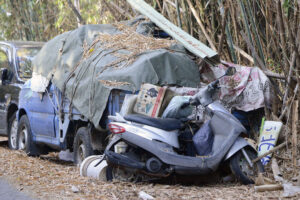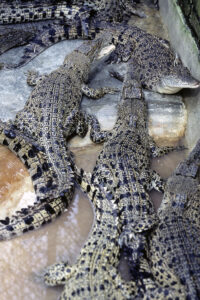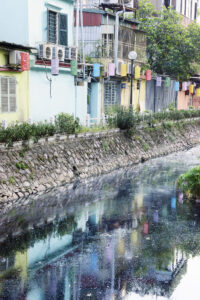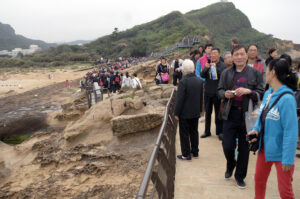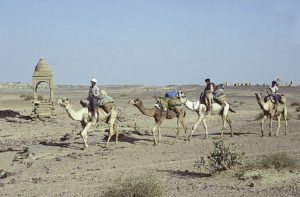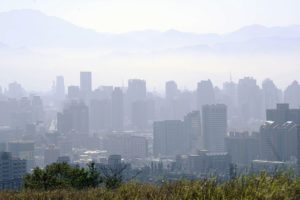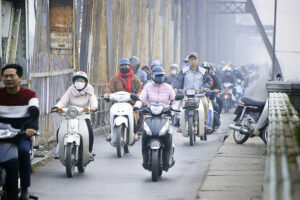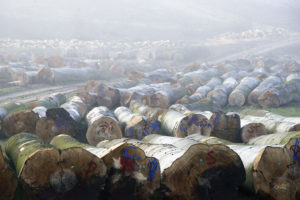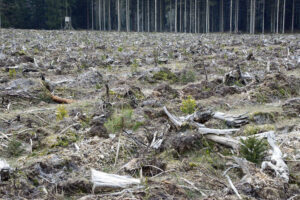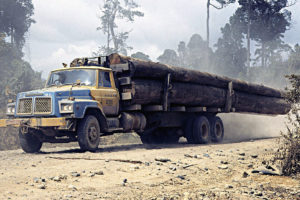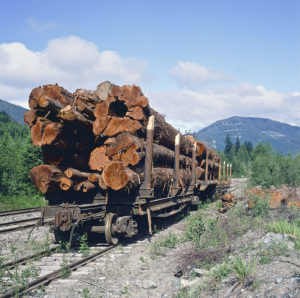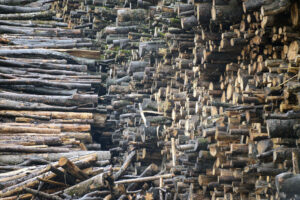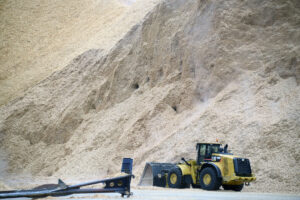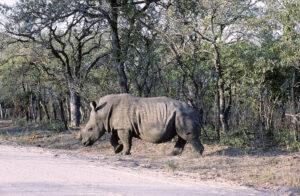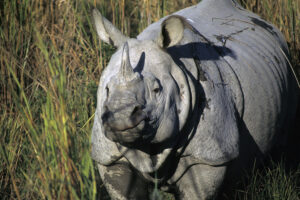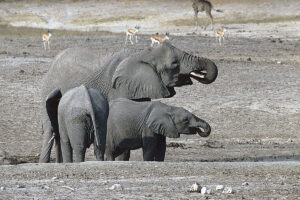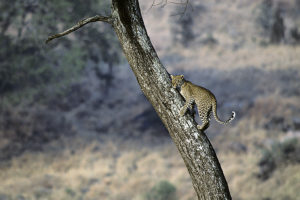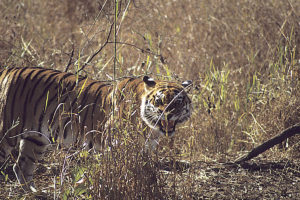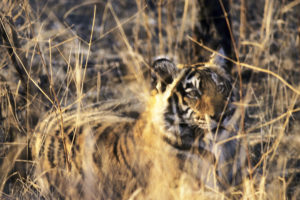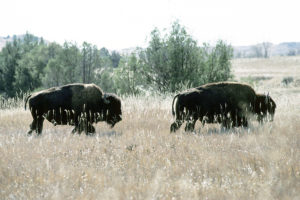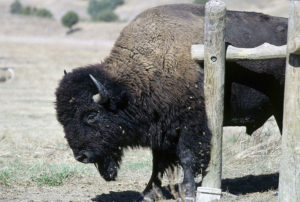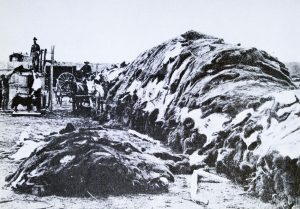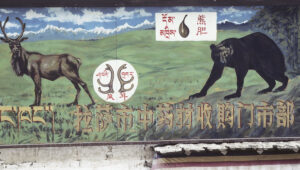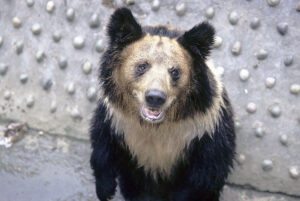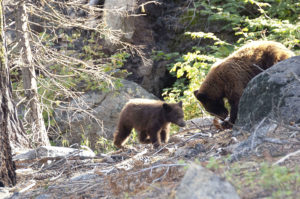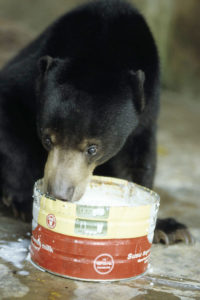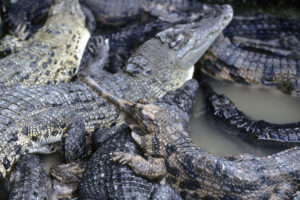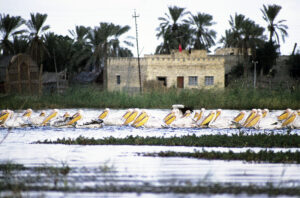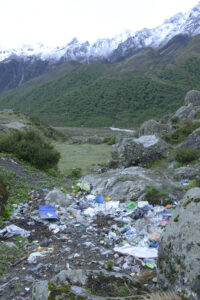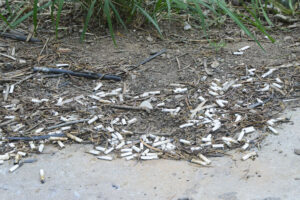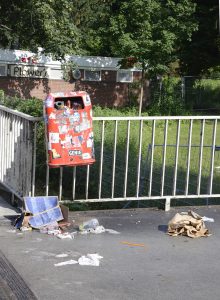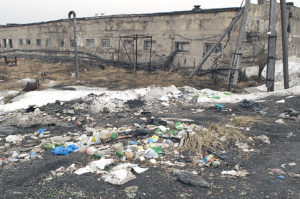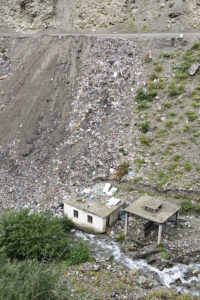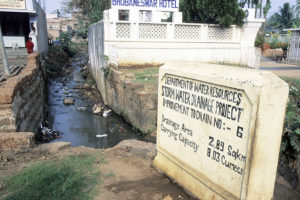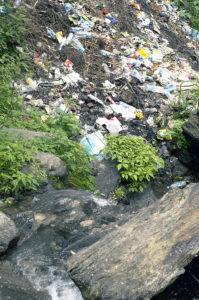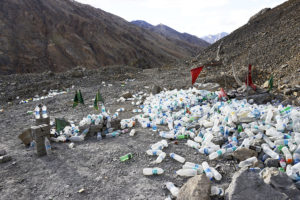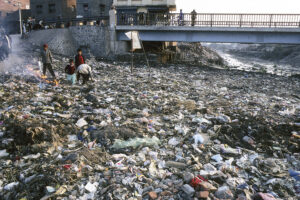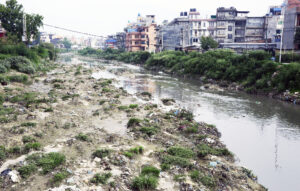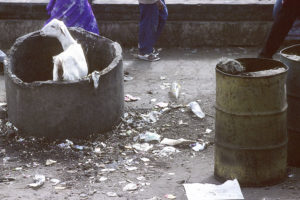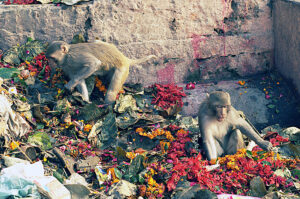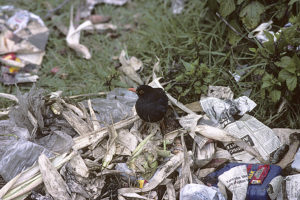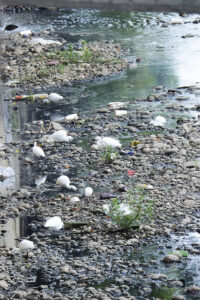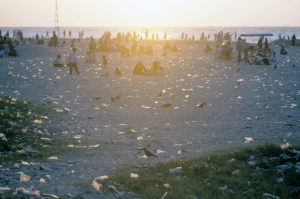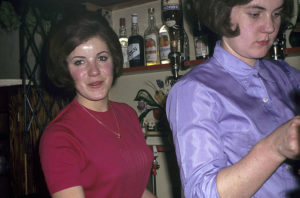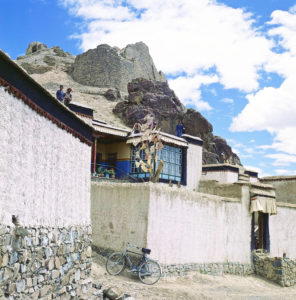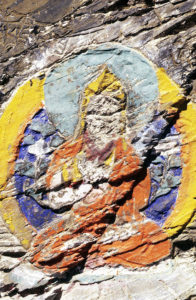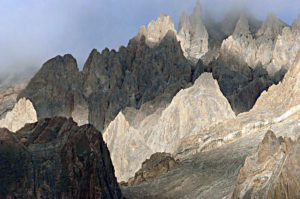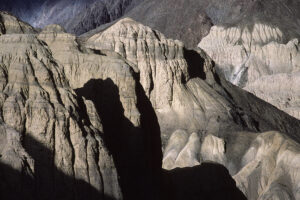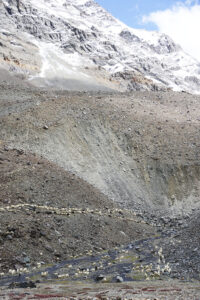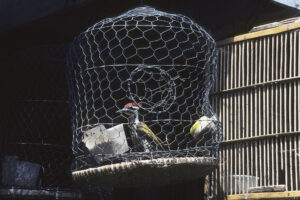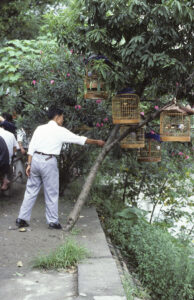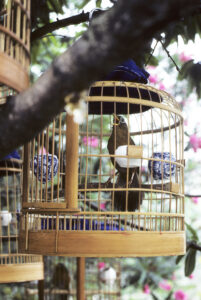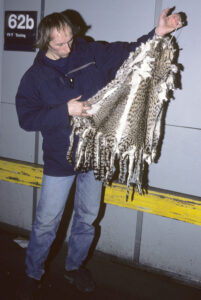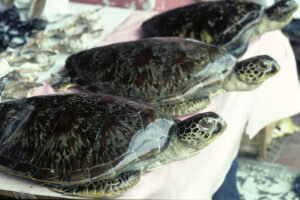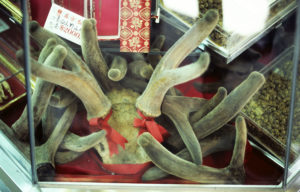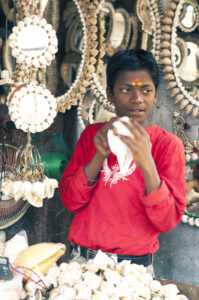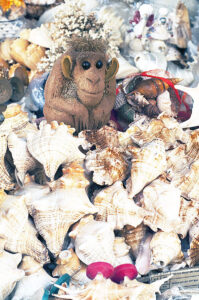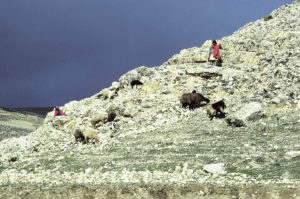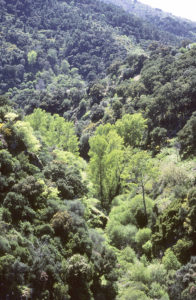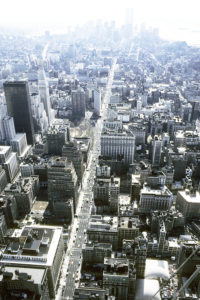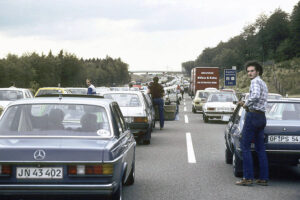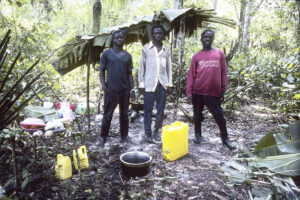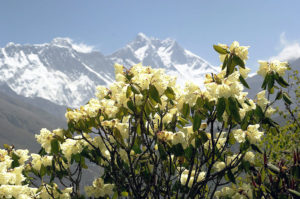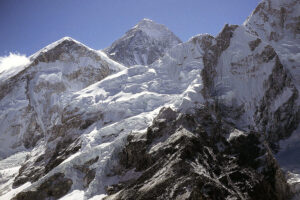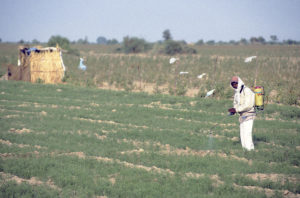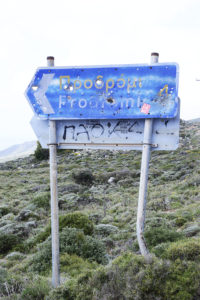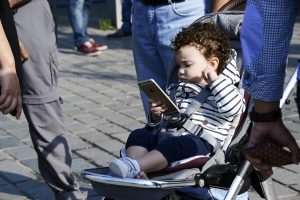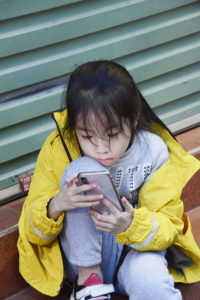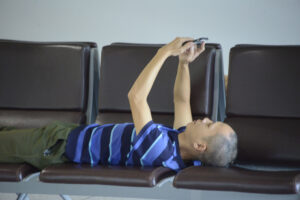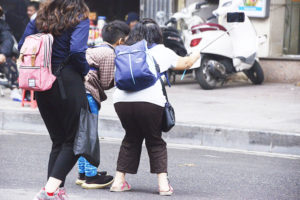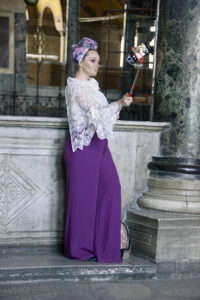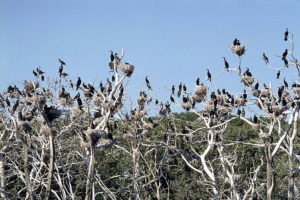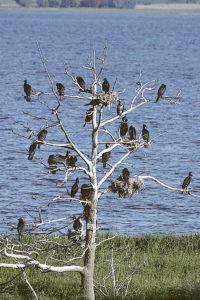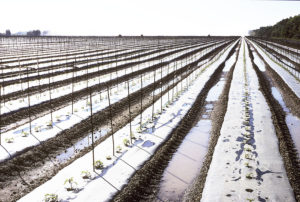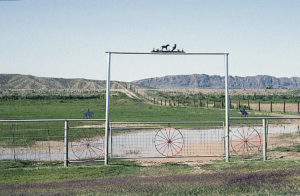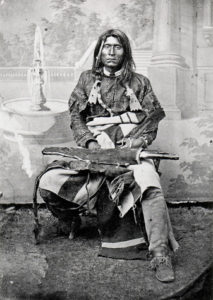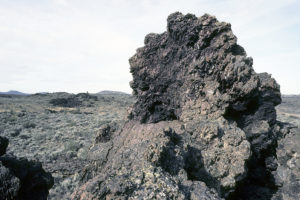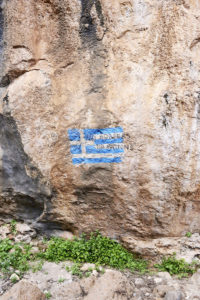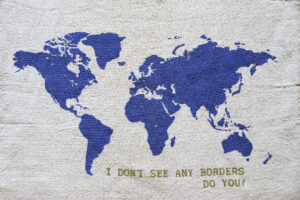Folly of Man
Every morning, when people go to work, and in the afternoon, when they go home again, hundreds of millions of scooters contribute significantly to the immense air pollution around the globe, as here in Hanoi, Vietnam. (Photo copyright © by Kaj Halberg)
“I presume that somebody will come and remove my wreck, so I’ll just leave it here.” – That is probably what the owners of car and scooter thought when they left them at the edge of this street in Taichung, Taiwan. (Photo copyright © by Kaj Halberg)
Siamese crocodiles (Crocodylus siamensis), photographed in a commercial breeding centre, Singapore. This species is highly threatened in the wild. (Photo copyright © by Kaj Halberg)
Smog in San Diego, California. (Photo copyright © by Kaj Halberg)
This idyllic scene from Hanoi, Vietnam, shows houses that are reflected in a canal. What is not obvious from the picture is that the water is highly polluted, black and stinking. In countless cities around the world, untreated sewage is led into the nearest body of water – a canal, a river, a lake, or directly into the sea. (Photo copyright © by Kaj Halberg)
The most dangerous animal in the world
“Should I once again, for God knows which time, write about the completely mindless excesses of an animal called Man, about the immense filth, created by the most dangerous animal in the world?”
Claus Bering (1919-2001), Danish artist and writer, in his book Grønbenede rørhøns (’Moorhens’, 1974). He once visited Nature Reserve Vorsø, Horsens Fjord, Denmark, where he said: “Man is the worst blunder of evolution.”
In his book The Snow Leopard (1978), American writer and environmentalist Peter Matthiessen (1927-2014) expresses the same attitude in this way: “We have outsmarted ourselves, like greedy monkeys, and now we are full of dread.”
Man was described scientifically in 1758 by Swedish naturalist Carl Linnaeus (1707-1778), who chose himself as the lectotype (a specimen later to be selected as the type specimen). He named us Homo sapiens (‘wise Man’, ‘skilful Man’).
However, when you look around and observe how we treat our environment, you come to the conclusion that we are very unwise. Homo perniciosus (‘destructive Man’) would be a much more appropriate name. Or maybe Man should be called: the most dangerous animal in the world.
We could act very wisely,
And treat the planet nicely,
If we only had a brain.
Inspired by the song If I Only Had a Brain, lyrics by Edgar Yipsel Harburg, born Isidore Hochberg (1896-1981), music by Harold Arlen, born Hyman Arluck (1905-1986), first performed in the film The Wizard of Oz (1939), in which it was sung by the Scarecrow, played by Ray Bolger (1904-1987).
Nuclear power plant, Krefeld, Nordrhein-Westfalen, Germany. (Photo copyright © by Kaj Halberg)
Petro-chemical industrial area, south of Kaohsiung, Taiwan. (Photo copyright © by Kaj Halberg)
Scrapped and stacked cars, Copenhagen, Denmark. (Photo copyright © by Kaj Halberg)
Scrapped cars, Greensburg, Pennsylvania, United States. (Photo copyright © by Kaj Halberg)
The United Nations has failed
I don’t understand the meaning of space programs. Billions of Dollars are spent sending space ships to the Moon and Mars, which are barren places, completely unsuited for people. Meanwhile, the Earth, which of course has perfect living conditions (otherwise we wouldn’t be here), is being abused and neglected on a grand scale. The main problem is the number of people on this planet.
The United Nations (UN) was founded in 1945 with the aim of “maintaining international peace and security, developing friendly relations among nations, achieving international cooperation, and being a center for harmonizing the actions of nations.” (Source: un.org)
All good intentions for the benefit of Mankind.
However, the UN has largely ignored the most important problem of all: population growth. Around 1800, the world population reached its first billion. It only took about 125 years to reach 2 billion around 1925, and then things went fast: 3 billion in 1960, 4 billion in 1974, 5 billion in 1987, 6 billion in 1999, and 7 billion in 2011.
Today we are almost 8 billion people, swarming like ants in most parts of the world, and the Earth is groaning under the massive impact from these immense crowds: forest clearing, soil erosion, desertification, mass extinction of plant and animal species, and a tremendous pollution of soil, water, and air, which contributes significantly to the climate change of recent years.
By largely ignoring population growth, the UN has failed completely.
“(…) swarming like ants.” – Hindu pilgrims, bathing in the sacred Gandak River, a tributary to Mother Ganges, near the city of Sonpur, Bihar, northern India. (Photo copyright © by Kaj Halberg)
“(…) swarming like ants.” – Chinese tourists in Yeliou Geopark, northern Taiwan. You don’t exactly have the area to yourself! (Photo copyright © by Kaj Halberg)
“(…) swarming like ants.” – Spectators, watching a theatre performance, Taichung, Taiwan. (Photo copyright © by Kaj Halberg)
On nuclear bombs
Rippled sand dunes with an akaro shrub (Calotropis procera), Thar Desert, Rajasthan. (Photo copyright © by Kaj Halberg)
“By afternoon, the wind had fallen silent over Pokhran. At 3:45 p.m., the timer detonated the three devices. Around 200 to 300 metres deep in the earth, the heat generated was equivalent to a million degrees centigrade – as hot as temperatures on the sun. Instantly, rocks weighing around a thousand tons, a mini mountain underground, vaporized. (…) shockwaves from the blast began to lift a mound of earth the size of a football field by several metres. One scientist, on seeing it, said, ‘I can now believe stories of Lord Krishna lifting a hill’.”
Ray Chengappa, ‘The Bomb Makers’, India Today, 22 June 1998, on India’s first blast of a nuclear bomb in the Thar Desert, Rajasthan.
“It’ll go down in history books, provided, of course, we have history books to go down in. Provided, of course, we have a future. There’s nothing new or original left to be said about nuclear weapons.
(…)
Once again, we [the Indians] are pitifully behind the times – not just scientifically and technologically (ignore the hollow claims), but more pertinently in our ability to grasp the true nature of nuclear weapons. Our Comprehension of the Horror Department is hopelessly obsolete. Here we are, all of us in India and Pakistan, discussing the finer points of politics and foreign policy, behaving for all the world as though our governments have just devised a newer, bigger bomb, a sort of immense hand grenade, with which they will annihilate the enemy (each other) and protect us from all harm.
(…)
If there is a nuclear war, our foes will not be China or America or even each other. Our foe will be the Earth herself. The very elements – the sky, the air, the land, the wind and water – will all turn against us. Their wrath will be terrible.
(…)
‘These are not just nuclear tests, they are nationalism tests’, we were repeatedly told. This has been hammered home, over and over again. The bomb is India, India is the bomb. Not just India, Hindu India. Therefore, be warned, any criticism of it is not just anti-national, but anti-Hindu. (Of course, in Pakistan the bomb is Islamic. Other than that, politically, the same physics applies.) This is one of the unexpected perks of having a nuclear bomb. Not only can the Government use it to threaten the Enemy, it can use it to declare war on its own people. Us.”
Arundhati Roy (born 1961), Indian author and environmentalist, in her book The Algebra of Infinite Justice, revised ed., 2002
You might wonder why the Indian government chose the wonderful Thar Desert for the outright lunacy described above. Why, of course for the same reason that the Americans chose the New Mexican desert for their nuclear tests in 1945: Should anything go wrong, the victims would be persons, who, in the eyes of the sophisticated city dwellers of Delhi or Washington, were ignorant country fools without any value to the nation.
You may be convinced of the glories of the Thar Desert by reading the pages Travel episodes – India 1986: “Sir, would you like to see this peacock?” and India 2003: Camel safari in the Thar Desert.
Further images from the wonderful Thar Desert: decorated house in the village of Khorma (top), camel riders (centre), and toothbrush tree (Salvadora oleoides). (Photos copyright © by Kaj Halberg)
Air pollution
Nowadays, the air pollution in many cities around the world is appalling. When you fly to one of these cities, it is often hidden in a cloud – not a usual cloud of moisture, but a cloud of polluted air, of a sickly yellowish-greyish colour, called smog – a combination of the words smoke and fog.
Once you dive into this cloud, you actually don’t see it, as if it was dissolved by magic. Many people live their entire lives in this blanket of harmful air, and it is a wonder that they do not all develop lung problems (although the number is steadily rising).
A significant part of this pollution stems from a vast number of scooters and motorcycles, many of which are equipped with two-stroke engines, which are far more polluting than the four-stroke engines of cars, because the fuel-air mixture in them gets contaminated with the lubricating oils of the engine. The combustion chamber draws in this contaminated mixture, as exhaust gases are expelled through the exhaust port, and some of the fuel and oil gets mixed with the exhaust.
Other culprits are trucks, which often drive on diesel of very low quality, sending out puffs of black smoke.
As early as in 1977, when this picture was taken, Ankara, Turkey, was almost hidden in a layer of smog. (Photo copyright © by Kaj Halberg)
Smog, dimming the outline of skyscrapers in the city of Taichung, Taiwan. (Photo copyright © by Kaj Halberg)
A significant part of the air pollution stems from a vast number of scooters and motorcycles. – In this picture, people go to work early in the morning, Hanoi, Vietnam. (Photo copyright © by Kaj Halberg)
Forest rape
“… a great deal of U.S. Forest Service land is designated as ‘multiple-use’, which is generously interpreted to allow any number of boisterous activities – mining, oil, and gas extraction; ski resorts (137 of them); condominium developments; snowmobiling; off-road vehicle scrambling; and lots and lots and lots of logging – that seem curiously incompatible with woodland serenity.”
William Bryson (born 1951), American writer, in his book A Walk in the Woods, 1998
Clear-cut forest of hundred-year-old beeches (Fagus sylvatica), Funen, Denmark. (Photos copyright © by Kaj Halberg)
Clear-cut coniferous plantation, Jutland, Denmark. (Photo copyright © by Kaj Halberg)
Transportation of logs, Sabah, Borneo. (Photo copyright © by Kaj Halberg)
Transportation of coniferous logs, Vernon Lake, Vancouver Island, Canada. (Photo copyright © by Kaj Halberg)
Logs for production of wood chips, Schweighofer Fiber, Hallein, near Salzburg, Austria. (Photos copyright © by Kaj Halberg)
On slaughter of wild animals
The number of animal species, which have been extirpated by Man, is appalling. Today, when forests around the world are being cleared at an alarming speed, a huge number, probably millions, of plant and animal species will vanish from this planet in the near future.
Rhinos, elephants, and larger cats may be the next large animals to be extirpated because of people’s thoughtlessness and greed.
“To me, the extirpation of an animal species is a criminal offence, in the same way as the destruction of anything we cannot recreate or replace, such as a Rembrandt or the Acropolis.”
Gerald Durrell (1925-1995), British writer and environmentalist, in his book A Zoo in my Luggage, 1960
“In eastern Africa, formerly the stronghold of the species [the black rhino], nine out of ten of these cumbrous, vulnerable and endearing creatures were wiped out. Most of the killing was done by poachers carrying out their cruel trade to meet the demand for rhino horn in Asia and the Middle East.
In the mid 1940s, a single hunter shot just under 1,000 rhinos in an area of 200 square kilometres in eastern Kenya, to make way for African settlement. By 1980, an area 100 times as large, the adjoining Tsavo National Park, held only about 150 surviving rhinos. An animal that has inhabited the Earth for some 60 million years is now reduced to a few thousands that cling onto survival in little pockets of bush and jungle set aside for their protection. And even there they are being relentlessly hunted, trapped and killed.”
Elspeth Huxley (1907-1997), English author, journalist, and environmentalist, in her introduction to the book Run, Rhino, Run, published in 1982, written by American geographer and conservationist Esmond Bradley Martin (1941-2018) and his wife Chryssee Bradley Martin. Esmond was murdered in his home in Kenya while writing a report about illegal ivory trafficking in Myanmar. Presumably, the murder was arranged by an illicit organization, which felt threatened by this report.
“Rhinos belong to everybody.”
Title of a book by German zoologist and environmentalist Bernhard Grzimek (1909-1987), Hill & Wang (1962).
However, the Chinese and other peoples in the Far East seem to think that rhinos belong only to them. As can be told from the quote above, only a tiny fraction of the former numbers of the world’s rhinos exist today. Thousands have been killed to meet the insatiable demand for rhino horn in the Far East, where it is ground to powder and used in folk medicine.
Rhino parts have been used as ingredients in traditional Asian medicine for at least 2000 years. Virtually every part of the animal is used: the horn for reducing fever and spasms; the skin for skin diseases; the penis as an aphrodisiac; the bones to treat bone disorders; the blood “as a tonic for women who are suffering from menstrual problems.”
In China, powdered horn is regarded as an aphrodisiac. However, chemical analyses have not revealed any active ingredients to suggest that the remedy could be effective in this respect.
In fact, western medical experts tend to discount all claims of any curative power in rhino horn. It is well known that aspirin contains similar properties and produces many of the same results as rhino prescriptions in patients.
Asian rhino horns are more highly prized than African rhino horns, as consumers believe that their smaller size means that they are more concentrated, and therefore more potent.
Formerly, rhino horn was also used for adorning dagger sheaths in Yemen – a practice which may still take place.
All five species of rhino are critically endangered due to widespread poaching and habitat loss.
Black rhinos (Diceros bicornis), greeting each other, Ngorongoro Crater, Tanzania. (Photo copyright © by Kaj Halberg)
This bull black rhino is sniffing a tuft of grass, into which a female has urinated, baring its lips in a posture, called flehmen. The inhaled air passes a special sensing organ, which is able to detect whether the female is in heat. – Ngorongoro Crater. (Photo copyright © by Kaj Halberg)
White rhino (Ceratotherium simum), Krüger National Park, South Africa. (Photo copyright © by Kaj Halberg)
Greater one-horned rhino (Rhinoceros unicornis), Kaziranga National Park, Assam, India. (Photo copyright © by Kaj Halberg)
“Japan and Hong Kong are steadily whittling away at the last of the elephants, turning their tusks (so much more elegant left on the elephant) into artistic carvings. In much the same way, the beautiful furs from leopard, jaguar, snow leopard, clouded leopard and so on, are used to clad the inelegant bodies of thoughtless and, for the most part, ugly women. I wonder how many would buy these furs, if they knew that on their bodies they wore the skin of an animal that, when captured, was killed by the medieval and agonizing method of having a red-hot rod inserted up its rectum so as not to mark the skin.”
Gerald Durrell (above), in his book The Aye-Aye and I: A Rescue Mission in Madagascar, 1993
African elephants (Loxodonta africana), drinking from a waterhole in Etosha National Park, Namibia. (Photo copyright © by Kaj Halberg)
This mother leopard (Panthera pardus) is climbing a tree, in which her kitten is feeding on an impala (Aepyceros melampus), Tarangire National Park, Tanzania. (Photo copyright © by Kaj Halberg)
Slaughter of the tiger
“My total bag of tigers is 1150 (one thousand one hundred and fifty only).”
The Maharaja of Surguja, in a letter to German-American biologist and environmentalist George B. Schaller, quoted in his book Stones of Silence: Journeys in the Himalaya, 1980
“(In India), according to historian Mahesh Rangarajan, “over 80,000 tigers…were slaughtered in 50 years from 1875 to 1925. It is possible that this was only a fraction of the numbers actually slain.” Not all were trophy-hunted: In some regions, the cats were considered vermin, systematically exterminated with incentive from government bounties.”
Sharon Guynup (born 1958), American writer, in blog.nationalgeographic.org/2014/03/10/a-concise-history-of-tiger-hunting-in-india
The population of tigers in India has dwindled to somewhere between 2,000 and 3,000, and at least a hundred are still killed annually by poachers to feed the Chinese market, where tiger parts are utilized in traditional medicine: the claws as a sedative for insomnia; the teeth for fever; the fat for leprosy and rheumatism; the nose skin for wounds; the bones for rheumatism and arthritis, dysentery, headache, and stiffness or paralysis of lower back and legs; the eyeballs for epilepsy and malaria; the tail for skin diseases; the bile for meningitis in children; the whiskers for tooth ache; the brain for laziness and pimples; the penis for usage in love potions, and as an aphrodisiac; the faeces for boils and haemorrhoids, and to cure alcoholism.
According to TRAFFIC, which is monitoring international wildlife trade, a minimum of 1,590 tigers were seized by officials between January 2000 and April 2014, feeding the illegal wildlife trade. (Source: WWF – Worldwide Fund for Nature, 2016)
This tigress is snarling at the elephant, on which I am sitting, Kanha National Park, India. (Photo copyright © by Kaj Halberg)
Young golden cat in golden grass, Ranthambhor National Park, India. (Photo copyright © by Kaj Halberg)
Slaughter of the bison
“The Sioux tribes (…) stalked buffalo and dried and pulverized the meat and mixed it with bone-marrow grease and wild berries and packed it in buffalo skin bags. The pemmican lasted indefinitely and had ten times the nutrient value of fresh meat. Tanned bison hides gave the Sioux shelters and bedding, moccasins, leggings, shields, boats, buckets, even vessels to boil food in. Horn and bone gave spikes, drills, knives, scrapers, axes, and spoons. Ribs and jawbones provided children with snowsleds. The hooves furnished glue, the scat heat. When a Sioux finished with a buffalo, he had used all of it, even its spirit, for it was the bearded buffalo (…) that stood at the heart of the rituals and religion of the Plains Indians.”
William Least Heat-Moon, also known as William Lewis Trogdon (born 1939), American author, in his book Blue Highways – A Journey into America, 1982
“Thirty years ago, millions of the great unwieldy animals existed on this continent. Innumerable droves roamed, comparatively undisturbed and unmolested (…) Many thousands have been ruthlessly and shamefully slain every season for the past twenty years or more by white hunters and tourists merely for their robes, and in sheer wanton sport, and their huge carcasses left to fester and rot, and their bleached skeletons to strew the deserts and lonely plains.”
In the Prime of the Buffalo, Overland Monthly and Out West Magazine, 14 (83), p. 515, 1889
”No sight is more common on the plains than that of a bleached buffalo skull; and their countless numbers attest the abundance of the animal at a time not so very long past. On those portions where the herds made their last stand, the carcasses, dried in the clear, high air, or the mouldering skeletons abound. (…) A ranchman who at the same time had made a journey of a thousand miles across northern Montana, along the Milk River, told me that, to use his own expression, during the whole distance he was never out of sight of a dead buffalo, and never in sight of a live one.”
Theodore Roosevelt (1858-1919), American president 1901-1909, written in the 1880s, quoted in P.R. Cutright, Theodore Roosevelt the Naturalist, 1956
American bison (Bos bison), Badlands National Park, South Dakota, United States. The lower picture shows a bull, rubbing on a fence. (Photos copyright © by Kaj Halberg)
Huge heaps of buffalo hides, Dodge City, Kansas, 1874. (Photo: Public domain)
Slaughter of bears
Bear paw soup is considered a valuable delicacy among many Asian peoples, including Chinese, Vietnamese, and Cambodians, supposedly giving the consumer the power and virility of a bear. One bowl of bear paw soup may cost as much as 1000 US$. Bear meat is also regarded as a delicacy in these societies.
Bear gall bladders are much utilized in Chinese traditional medicine for treatment of skin problems and severe cases of red and swollen eyes, and also for clearing the eyesight, removing toxins and parasites from the body, alleviating spasms, increasing release of bile, improving absorption of vitamin D and calcium, and reducing fever, swellings, and pain.
Due to illegal hunting, bears have disappeared, or become very rare, in many areas, including Europe, Southeast Asia, Korea, China, and Taiwan. Many bears are kept in captivity to supply the various markets. In South Korea, for instance, only around ten Asian black bears, or moon bears (Ursus thibetanus), live in the wild, whereas c. 1600 are kept in captivity, often under horrible conditions. These captive bears are often killed in the most cruel and horrendous ways, and that this practice is illegal does not seem to deter consumers.
Previously, the Asian black bear was a totem animal to various indigenous tribes in Taiwan, and it was a sign of courage to kill one. Today, the bear is extremely rare in the island. It is strictly protected, but is only very slowly recovering, presumably due to being vulnerable to diseases, caused by inbreeding.
As numbers dwindled in other areas, the attention of poachers, in the 1990s, shifted to western North America, which houses a large number of brown bears (Ursus arctos) and American black bears (U. americanus). Since then, numerous bears have been illegally collected here, intended for Asian societies in American cities, to be served as bear paw soup, or for production of traditional medicine.
Today, five of the world’s eight bear species are endangered.
Poster in Lhasa, Tibet, announcing traditional Chinese medicine for sale: bear gall bladders and deer antlers. (Photo copyright © by Kaj Halberg)
Asian black bear, photographed in Chengdu Zoo, Sichuan Province, China. (Photo copyright © by Kaj Halberg)
Female American black bear with a cub, Sequoia National Park, Sierra Nevada, California. (Photo copyright © by Kaj Halberg)
This young sun bear (Helarctos malayanus) was confiscated from poachers and is now kept in captivity, until it is old enough to be released in nature. – Sepilok Orangutan Rehabilitation Centre, Sabah, Borneo. (Photo copyright © by Kaj Halberg)
Slaughter of the sea otter
“The sea otter is gentle and relatively tame; its suspicion of Man came to it late.
(…)
The United States proceeded with the destruction of the sea otters, and the Alaska Company took 47,482 skins between 1881 and 1890. In 1900, however, only 127 skins were taken, and ten years later the season’s catch of a fleet of sixteen schooners was less than two per ship. As a result, the fur traders offered no resistance when, in the following year, an international treaty was set up to protect all otters north of the Thirtieth Parallel – Baja California and southern Japan – a measure which made a sanctuary of their entire range. The sale of sea-otter fur was forbidden in the United States and Alaska, and the last legal pelt, marketed in London that year, brought nearly two thousand dollars.
Meanwhile, the sea otters of the United States had disappeared entirely, and it was not thought that the species would survive long anywhere. But in 1933, a few individuals were located off the California coast.”
Peter Matthiessen (1927-2014), American writer and environmentalist, in his book Wildlife in America, 1959, revised ed. 1987.
Before the fur trade began in the 1740s, the population of sea otters is thought to have been between 150,000 and 300,000 in the North Pacific, from northern Japan along the coasts of Russia and America to Baja California Peninsula in Mexico. The fur trade reduced the sea otter’s numbers to an estimated 1,000 to 2,000.
Since its protection, the sea otter has made a dramatic comeback, and the total population may be as high as c. 110,000 individuals, with the most stable population, counting c. 27,000, living in Russia, notably on the Kuril Islands.
Sea otter (Enhydra lutris), female and young, Point Lobos, California. The female is lying on her back, eating an abalone (Haliotis). Shortly after this picture was taken, the pup grabbed the abalone from the mother’s belly. (Photo copyright © by Kaj Halberg)
Slaughter of crocodiles
Although most people tend to think of crocodiles as horrible, primitive creatures, they are in fact intelligent, sociable, feeling animals, who even enjoy playing together, and the females have strong maternal bonds.
Crocodiles have been hunted relentlessly due to their reputation as man-eaters, and also to provide skins for the leather industry, where they are used in the production of luxury items such as handbags, shoes, belts, wallets, and upholstery.
The current international trade involves over 1.5 million skins per year, exported legally from about 30 countries. The animals are kept under cruel conditions in small cages or concrete ponds, with extremely little space for each animal. A crocodile raised in a farm will be killed when it is just 2-3 years old, whereas the lifespan of these animals in the wild is up to 30 years.
Out of 18 species worldwide, 6 are listed as critically endangered by the IUCN.
Any industry which requires the captivity and slaughter of animals can never be ethical.
False gharials (Tomistoma schlegelii) and Siamese crocodiles (Crocodylus siamensis), living under cruel conditions in a commercial breeding centre, Singapore. (Photo copyright © by Kaj Halberg)
Slaughter of elephant seals
”The elephant seal, so named for its bizarre proboscis, ranged as far north as Point Reyes, and yielded about three barrels of oil per carcass, as well as a tongue deemed succulent. It was easily taken, perhaps because, as Fanning suggested, ‘The loudest noise will not awaken these animals when sleeping’. In any case, its oil was thought superior to that of the sperm whale, which was then disappearing, and as a consequence its most famous days occurred from 1855 until 1870, the year when it was presumed exterminated from the Northern Hemisphere. In 1892, nine specimens were located at Guadalupe, and seven of these, sad to say, were collected by excited scientists. Apparently, a few remained at sea, however, for the species restored itself once more under protection.”
Peter Matthiessen (1927-2014), American writer and environmentalist, in his book Wildlife in America, 1959, revised ed. 1987
Since the early 20th Century, the northern elephant seal (Mirounga angustirostris) has been protected by law in Mexico and the United States, and, subsequently, it has now recovered, today counting more than 200,000 individuals, occurring in scattered breeding colonies along the Pacific Coast, from Baja California at least as far north as British Columbia.
Part of a large congregation of moulting northern elephant seals, Año Nuevo State Park, California. A male is kicking sand on himself to relieve the itching. (Photo copyright © by Kaj Halberg)
Elephant seals derive their name from their great size, and also from the male’s large, inflatable proboscis, with which he makes loud roaring noises, especially during the mating season. – This male northern elephant seal is courting a female, San Simeon, California. (Photo copyright © by Kaj Halberg)
Slaughter of birds
“(…) duck and geese were becoming fewer year by year. In 1951 I had seen duck flighting in at sunset to feed on harvested rice-fields near Saigal, in such numbers that they reminded me of swarms of locusts. When I left the marshes in 1958 there were nothing like as many. A million cartridges were imported annually at that time into Iraq, and most of the people who used them counted on getting at least one bird with a shot. A heavy toll was also taken of wild-fowl by professional fowlers, who netted them a hundred or more at a time.”
English author Wilfred Thesiger (1910-2003), in his book The Marsh Arabs (1964), about the number of birds in the marshes of southern Iraq.
When I visited the marshes of Iraq in 1973 (see Travel episodes: Iraq), we rarely observed rafts of duck counting over a hundred, and only coot was numerous.
During the First Gulf War (1990-1991), the local people, the Madan, sided with the American forces, because, being Shi’ites, they – justly – felt persecuted by the Sunni government in Baghdad. As a retaliation, Saddam Hussein let the marshes drain after the war, putting an end to a way of life that had existed for thousands of years. Today, a part of the marshland has been restored, and birds have returned, but only a fraction of former numbers, and hunting is still excessive.
Unfortunately, the example above is not unique. Everywhere on the planet, birds are declining alarmingly due to overhunting, draining of wetlands, clearing of forest to create more farmland, conversion of shallow coastal waters to prawn farms, rice fields, and salt pans, etc.
The division of Muslims into Sunnis and Shi’ites is described on the page Religion: Islam.
White pelicans in the marshes of southern Iraq, 1973. (Photo copyright © by Kaj Halberg)
Ubiquitous garbage
To me, throwing garbage at random is a clear sign of spiritual decay, but, unfortunately, a phenomenon, which is only too common around the world.
In many poor countries, the garbage is taken just outside the city limit and dumped in empty lots, in a river, or down the nearest slope.
However, disposal of garbage outside garbage dumps is not a phenomenon restricted to poor countries. In later years, in the so-called ‘developed’ countries, a growing indifference to garbage everywhere seems to have become prevalent.
The authorities in the national parks of Nepal show a complete lack of understanding the aim of nature protection. Around villages and hotels, garbage is piling up, as here outside the hotels near Kyangjin Gompa, Langtang National Park, in 2022. (Photo copyright © by Kaj Halberg)
In this picture from Kintamani, Bali, Indonesia, garbage is littering a slope at the outskirts of town. (Photo copyright © by Kaj Halberg)
“Well, somebody will come and clean up after me!” – That is probably what the car driver thought when he emptied his ash tray at the edge of this street in Taichung, Taiwan. (Photo copyright © by Kaj Halberg)
Outside Hamburg Railway Station, Germany, garbage is littering the walkway around this container. It seems that, to some people, the task of throwing their garbage into the container is too difficult. (Photo copyright © by Kaj Halberg)
During the heydays of the Soviet Union, the town of Anadyr, situated on the Chukotka Peninsula, eastern Siberia, was of huge importance due to the presence of a gigantic missile launch, in which several missiles, armed with nuclear weapons, were aimed at various targets in the United States. Following the collapse of the Soviet Union, the whole business was covered with soil, and the importance of Anadyr vanished.
Today, this area bears the marks of decay and indifference, in equal measures. Rubble, wires, iron pipes, oil drums, scrapped trucks, workmen’s huts, and a lot of other rubbish is ubiquitous, and nobody shows any incentive to clean up the mess. During the Soviet Era, you just did what you were told, which does not exactly encourage personal initiative. Today, when you are not told to do anything, it seems that nobody wants to take the trouble to clear the mess, and thus beautify the area.
Our adventures in Chukotka are related on the page Travel episodes – Siberia 2011: Caterpillar trip in Chukotka.
A pile of garbage in front of an abandoned factory building in Anadyr – one of these huge concrete buildings, devoid of charm, which the former Soviet government was so fond of building. (Photo copyright © by Kaj Halberg)
These years, many Indians are boasting about the booming economy of their country. However, when it comes to pollution control and garbage disposal, India is lagging hopelessly behind. The pictures below show some examples of this fact.
This small Buddhist shrine near Keylong, Lahaul, Himachal Pradesh, has been defaced by numerous truck-loads of garbage. (Photo copyright © by Kaj Halberg)
This drainage canal in Bhubaneswar, Odisha (Orissa), also functions as a garbage dump. (Photo copyright © by Kaj Halberg)
Garbage in a riverbed, Manali, Himachal Pradesh. (Photo copyright © by Kaj Halberg)
In Ladakh, northern India, mountain passes, road turns, and other striking places along roads are usually adorned with numerous Buddhist prayer flags. But near the Niki La Pass, travellers got the peculiar habit of marking a road turn with empty plastic bottles. They may think that they adorn the place, but, during the frequent winter storms, which afflict this area, the bottles blow about, littering the surrounding landscape.
(Photo copyright © by Kaj Halberg)
The above-mentioned cases, however, are nothing compared to the condition in many large cities. An award-winning picture from World Press Photo 2019 shows a boy sleeping on a mattress, which is floating about in a morass of other garbage in the Pasig River, Manila, Philippines. The text to this picture reads as follows: ”The Pasig River was declared biologically dead in the 1990s, due to a combination of industrial pollution and waste being dumped by nearby communities living without adequate sanitation infrastructure. A 2017 report by Nature Communications cites the Pasig as one of the 20 most polluted rivers in the world, with up to 63,700 tons of plastic deposited into the ocean each year. Efforts are being made the clean up the Pasig, which were recognized by an international prize in 2018, but in parts of the river the waste is still so dense that it is possible to walk on top of the garbage.”
Another grim situation is prevalent in Kathmandu, the capital of Nepal, where the ruling upper class shows an appalling lack of initiative, when it comes to encroachment of nature. Renovation in this city is largely non-existing, and lots of garbage is left in the streets, or dumped into the rivers, where the monsoon rain (when it finally arrives) washes the garbage down to the Indians on the Gangetic Plain. Meanwhile, it is piling up in the river beds.
It is often NGOs or local groups who must step in, when it comes to molestation of nature, as local politicians and civil servants are too busy filling their own pockets to care about these things. The money, which they obtain through corruption and bribing, is spent to acquire expensive mansions and luxury cars like Porsche, Lexus, or Mercedes, so that they can drive around in the city among the mob and feel important – the very mob, many of which voted for them, and whom they were elected to serve.
These poor children are searching for items, which they can sell, in a huge pile of garbage along the shores of the Vishnumati River, Kathmandu. (Photos copyright © by Kaj Halberg)
The children are accompanied by cattle, pigs, and house crows (Corvus splendens), searching for edibles among the garbage. (Photo copyright © by Kaj Halberg)
The pictures above were taken in 1994. As seen in the picture below, showing the Vishnumati River in 2022, things had hardly improved in the intermediate period.
(Photo copyright © by Kaj Halberg)
Naturally, animals do not regard garbage as unaesthetic, and you often encounter various animals, searching for edibles in garbage heaps or in polluted rivers. In Indian cities, part of the garbage disposal is often carried out by domestic animals like cows or goats, which roam freely in the streets.
Zebu ox, eating garbage from a wheelbarrow, Udaipur, Rajasthan. This ox is described in depth on the page Animals: Animals as servants of Man. (Photo copyright © by Kaj Halberg)
In the town of Ooty, Tamil Nadu, this goat is searching for food in a garbage container. What looks like tousled hair, sticking out of the drum to the right, is in fact tousled hair. A mad person has taken shelter in the drum and is now sleeping. (Photo copyright © by Kaj Halberg)
These rhesus monkeys (Macaca mulatta) are searching for edibles among discarded malla (flower) garlands and other rubbish, which was presented as offerings by Hindu pilgrims to the sacred Ganges River, Varanasi, India, and has now been removed from the river itself and dumped on the shore. – The rhesus monkey is described on the page Animals – Mammals: Monkeys and apes, whereas the Ganges River is presented on the page Religion: Hinduism. (Photo copyright © by Kaj Halberg)
Male Nilgiri blackbird (Turdus simillimus), feeding in a heap of garbage on Dodabetta (2637 m), the highest peak in the Nilgiri Mountains, Tamil Nadu, South India. This mountain is also a popular picnic spot, which is obvious from the huge amounts of garbage left here. – The Nilgiri blackbird and other thrushes are presented on the page Animals – Birds : Thrushes. (Photo copyright © by Kaj Halberg)
In Taiwan, which is supposedly a developed and modern country, garbage in rivers and drainage canals is only too common a sight. Untreated sewage water also often flows down the canals, stinking awfully.
Paradoxically, these canals are good places to observe birds, some coming to drink, others to feed among the dirt. They seem to completely ignore the stink. Among birds that I have observed in these canals, are little egret (Egretta garzetta), black-crowned night-heron (Nycticorax nycticorax), Javan myna (Acridotheres javanicus), common sandpiper (Actitis hypoleucos), common kingfisher (Alcedo atthis), black bulbul (Hypsipetes leucocephalus), and grey wagtail (Motacilla cinerea). – Pictures, depicting these species, are shown on the page Animals – Birds: Birds in Taiwan.
Little egrets, feeding in a drainage canal, Taichung, Taiwan. – What is a heron, and what is garbage? (Photo copyright © by Kaj Halberg)
In later years, people have realized that plastic is one of the worst sources of sea pollution, especially in the form of the so-called micro plast, tiny bits of plastic, which is eaten by plankton, and then further concentrated up through the food chain. Floating plastic bags are often eaten by sharks, sea turtles, and other animals, and when the indigestible bags concentrate in their guts, they face a slow, painful death of starvation.
Evening atmosphere on a popular picnic beach, Kochi, Kerala, South India. The beach is littered with discarded plastic bags. (Photo copyright © by Kaj Halberg)
Rattling skeletons
Fashion shows often appear on TV. In a most affected walking style, a line of alarmingly skinny women marches down a platform, along which a number of women and effeminate men clap their hands enthusiastically, watching these fantastic robes, which no reasonably normal woman would dream of wearing.
One thing is that the clothes are peculiar. If you dare to comment on them, you are told that this is fashion, and you don’t know anything about that. All right, that may be so, but why do the women, who display these rags, have to be so thin?
They are often role models for young and insecure girls, for whom the worst nightmare is to be different from their friends. To become like their role models, many of them starve themselves, and a small percentage end up suffering from anorexia – a life-threatening ailment.
Please, in the name of salubrity, can we have fashion models that look like ordinary, healthy women instead of rattling skeletons?
In the name of salubrity, can we have fashion models that look like ordinary, healthy women, like these Bena Kabende women in Zambia, or these bar maids in a hotel in Austria? (Photos copyright © by Kaj Halberg)
Folly of Mao Zedong
“Political power grows out of the barrel of a gun.”
Mao Zedong (1893-1976), leader of the Communist Party of China, during a meeting August 7, 1927, and repeated several times later.
“(…) enormous amounts of investment produced only modest increases in production or none at all. (…) In short, the Great Leap was a very expensive disaster.”
Dwight Perkins (born 1934), American economist and Sinologist, in The Cambridge History of China, Vol. 15, Chapter 6, 1991
“The Cultural Revolution was responsible for the most severe setback and the heaviest losses suffered by the Party, the country, and the people, since the founding of the People’s Republic.”
Communist Party of China, in Resolution on Certain Questions in the History of Our Party Since the Founding of the People’s Republic of China, 1981
In 1949, when the Chinese communist army had overrun the Guo-min-dang forces, led by Chiang Kai-shek (1887-1975), Mao Zedong took command, proclaiming the People’s Republic of China. In 1958, he instigated the so-called Great Leap Forward, the aim of which was to to transform China from an agricultural country to an industrialized nation, based on Socialism.
As it turned out, this movement was a disaster. Estimates vary, but, between 1958 and 1962, somewhere between 30 and 45 million people died, mainly of starvation due to failing crops.
In 1966, Mao instigated another movement, the so-called Great Proletarian Cultural Revolution, claiming that bourgeois elements had infiltrated the society, and also the government, with the aim of restoring capitalism. By destroying the Four Olds, i.e. old customs, culture, habits, and ideas, this movement would preserve Chinese communism and re-enforce the thoughts of Mao in the Party.
To eliminate his rivals within the Party, Mao insisted that revisionists be removed through violent class struggle. Countless so-called Red Guard groups were formed throughout the country, and millions of people suffered a wide range of abuses, including public humiliation, arbitrary imprisonment, torture, hard labour, seizure of property, and often execution.
Minorities around the country suffered enormous casualties, especially among religious practitioners. In Inner Mongolia, some 790,000 people were persecuted, 22,900 were beaten to death, and 120,000 were maimed. In Sinkiang, Muslim imams were paraded around with paint splashed on their bodies. In Tibet, thousands of Buddhist monks were killed, and hundreds of children of Tibetan nobles were abducted from their home, being brainwashed to regard their parents as contra-revolutionary traitors.
The destruction of cultural treasures around the country was appalling. In Tibet, for example, all but seven of the initial 6,000 Buddhist monasteries were more or less destroyed, often by local ethnic Tibetan Red Guards. In Sinkiang, numerous mosques were defaced, and in ethnic Korean areas of north-eastern China, language schools were destroyed.
A list of sources may be found on the following website: en.wikipedia.org/wiki/Cultural_Revolution
Performance of the ballet The Red Detachment of Women, one of the Model Dramas promoted during the Cultural Revolution. (Photo by Byron Schumaker, Public Domain)
The 10th Panchen Lama, second leader of Lamaism after the Dalai Lama, during a so-called thamzing (‘struggle session’), 1964. A thamzing was a form of public humiliation and torture of those deemed class enemies by the Communist Party of China, particularly during the Cultural Revolution. (Photo: Public Domain)
Previously, Samdup-tse Dzong, the fort in Shigatse, Tibet, was the seat of the local government. It was almost completely destroyed by local Red Guards during the Cultural Revolution. (Photo copyright © by Kaj Halberg)
This image, depicting a meditating monk, is painted on a rock on the pilgrim route, or kora, around Lhasa, Tibet. It was defaced during The Cultural Revolution. (Photo copyright © by Kaj Halberg)
Stones of silence
“For epochs to come the peaks will still pierce the lonely vistas, but when the last snow leopard has stalked among the crags, and the last markhor has stood on a promontory, his ruff waving in the breeze, a spark of life will have gone, turning the mountains into stones of silence.”
George B. Schaller (born 1933), German-American biologist and environmentalist, in his book Stones of Silence: Journeys in the Himalaya, 1980
Morning sun and shadows on eroded mountains, Shila River Valley, near Honupatta, Ladakh, India. (Photo copyright © by Kaj Halberg)
Evening shadows on eroded rocks, Lamayuru, Ladakh. (Photo copyright © by Kaj Halberg)
Huge mixed flock of sheep and goats on an overgrazed slope, Bara Lacha Pass, Lahaul, Himachal Pradesh, India. (Photo copyright © by Kaj Halberg)
The pet and wildlife trade
These types of trade treat animals as mere money-making commodities to be mass-produced and peddled for profit. In most cases, animals are denied socialization, exercise, and even basic veterinary care in this cruel, money-hungry industry.
Worst of all, this trade encourages the public to view animals as impulse purchases no different from fashion products that are acquired on a whim and discarded when the novelty wears off – rather than thinking, feeling beings who deserve love and respect.
Every year, people succumb to the temptation to purchase ‘exotic’ animals like hedgehogs, macaws, lizards, snakes, tortoises, frogs, or monkeys, and even tigers and bears, from stores, auctions, or the internet, to keep them as ‘pets’. But often life in captivity rapidly leads to pain and death for these animals, who can easily suffer from malnutrition, an unnatural and uncomfortable environment, loneliness, and the overwhelming stress of confinement.
The exotic animal trade is also deadly for animals we don’t see. For every animal who makes it to the store or the auction, countless others die along the way.
The above text is a slightly altered version of a text, borrowed from the website peta.org/issues/animal-companion-issues/pet-trade.
Bird trade, legal as well as illegal, takes place on a huge scale in many parts of Asia. Bird markets are found in numerous cities, where millions of birds are kept under cruel conditions in tiny cages. The dealers are oblivious of the sufferings of the birds. A major part of the birds are sold as pets, but a great deal also end their days as food for humans.
This picture shows a bird market in Yogyakarta, Java, Indonesia, where songbirds and other birds, besides other animals, including monkeys, rabbits, squirrels, and also dogs, were displayed for sale. All of these animals (except the songbirds) were intended for human consumption, including the dogs. (Photo copyright © by Kaj Halberg)
Common flameback, or golden-backed woodpecker (Dinopium javanense), for sale, Yogyakarta. (Photo copyright © by Kaj Halberg)
This Javan lutung (Trachypithecus auratus) was also for sale at the bird market in Yogyakarta. (Photo copyright © by Kaj Halberg)
This orange-headed ground-thrush (Geocichla citrina ssp. rubecula) was for sale at a bird market in the town of Kintamani, Bali, Indonesia. (Photo copyright © by Kaj Halberg)
Birds for sale at a market in Old Delhi, India: ring-necked parakeets (Psittacula krameri, bottom cage), and budgerigars (Melopsittacus undulatus) and white estrildid finches. (Photo copyright © by Kaj Halberg)
Lord Derby’s parakeet (Psittacula derbiana) is a rare parrot, which is restricted to a rather small area of moist evergreen forest in the Indian states of Arunachal Pradesh and Assam, and adjoining parts of Tibet, Sichuan, and Yunnan in China. This species suffers from poaching for the illegal wildlife trade, and also from habitat destruction, as many of the old trees with suitable holes as nesting sites, are cut down by the timber industry.
Male Lord Derby’s parakeet, kept in captivity, Chengdu, Sichuan Province, China. (Photo copyright © by Kaj Halberg)
Those birds, which do not end on the dinner table, often spend the rest of their lives in small cages, where they are supposed to entertain their owner. In China, a popular pastime is to participate in competitions, the purpose of which is to see, whose caged bird is the best singer.
Red-whiskered bulbul (Pycnonotus jocosus) in a small cage, Hanoi, Vietnam. (Photo copyright © by Kaj Halberg)
Singing competition, Chengdu, Sichuan Province, China. (Photo copyright © by Kaj Halberg)
This Chinese hwamei (Garrulax canorus) participates in a singing competition, Chengdu. (Photo copyright © by Kaj Halberg)
Wildlife products are also traded on a huge scale, in countless cases illegally. Bones and skins from tigers, lions, snow leopards, and other cats, rhino horns, ivory, and innumerable other wildlife parts end up in the insatiable markets for traditional medicine and handicrafts in the Far East, causing many species to be on the brink of extinction.
Posters in Lhasa, Tibet, announcing sale of bones of snow leopard (Panthera uncia), glands of musk deer (Moschus), deer antlers, and gall bladders from bears. (Photos copyright © by Kaj Halberg)
Danish biologist Ib Krag Petersen, showing pelts of Geoffroy’s cat (Leopardus geoffroyi), confiscated in Copenhagen Airport, Denmark. (Photo copyright © by Kaj Halberg)
Lacquered hawksbill turtles (Eretmochelys imbricata), green turtles (Chelonia mydas), and sea shells for sale, Yogyakarta, Java, Indonesia. (Photos copyright © by Kaj Halberg)
Deer antlers in velvet for sale, Kowloon, Hong Kong. (Photo copyright © by Kaj Halberg)
Sea shells are very popular souvenirs in many parts of the world, and numerous species are threatened by over-collecting. These pictures are from the city of Haridwar, Uttarakhand, India. (Photos copyright © by Kaj Halberg)
A lovely, spoilt country
”Very few places in the world have been more abused by Man than the warm, sunny lands around the Mediterranean. Forests and soil have been destroyed by ax, fire, and domestic animals. Today, this area, although still beautiful, is a mere shadow of its former self, and only here and there you may have a wistful glimpse of the rich wildlife that once was.”
François Bourlière (1913-1993), French physician and naturalist, in the Life Natural Library book The Land and Wildlife of Eurasia, 1964
Next to forest clearing, domestic goats are the main culprits in transforming the Mediterranean lands to naked, barren rocks, as they eat almost any plant, gnawing it down to ground level, paving the way for increased soil erosion.
Goats are the main culprits in the destruction of Mediterranean lands. – Crete, Greece. (Photo copyright © by Kaj Halberg)
Children, herding sheep and goats in a stony, barren area west of Maktar, Tunisia. Black rain clouds are looming on the horizon. (Photo copyright © by Kaj Halberg)
Barren mountains, El Torcal de Antequera, Andalusia, Spain. The yellow-flowered shrubs are a species of broom, of the pea family (Fabaceae). (Photo copyright © by Kaj Halberg)
A few scattered Lebanon cedars (Cedrus libani) are all that remains of former extensive cedar forests in the Toros Dağlari Mountains, southern Turkey. As far back as the classical antiquity, this species was extensively cut for construction: King Solomon ordered the Temple of Jerusalem to be built of cedar timber. (Photo copyright © by Kaj Halberg)
A glimpse of the former glory: Lush river valley with poplars, olive trees, and cork oaks (Quercus suber), Jubrique, Andalusia, Spain. (Photo copyright © by Kaj Halberg)
Cities and highways are growing out of control
“We amplify and beautify the centers of congregation for fast redoubling human populations without giving equivalent thought to the living space of man’s fellow creatures, or to the soil and ground water.”
Robert Cushman Murphy (1887-1973), American ornithologist and environmentalist, in his book Fish-shape Paumanok – Nature and Man on Long Island, 1964
“Year after year, our scenic treasures are being plundered by what we call our advancing civilization. If we are not careful, we shall leave our children a legacy of billion-dollar roads leading nowhere except to other congested places like those they left behind.”
Omar Nelson Bradley (1893-1981), American general and environmentalist, quoted in the book Fish-shape Paumanok – Nature and Man on Long Island, 1964
View south from Empire State Building, Manhattan, New York City. The twin towers of the World Trade Center, which were destroyed during a terror attack in September 2001, can be glimpsed in the background. (Photo copyright © by Kaj Halberg)
Traffic jam on a highway, near Kassel, Germany. (Photo copyright © by Kaj Halberg)
On minuscule grants to biologists
“It has always amazed me that these people who are trying to learn and understand the world around us before it is bulldozed out of existence, have to work on piteously low salaries or on minuscule and precarious grants, while they do one of the most important jobs in the world. For it is only by learning how the planet works that we will see what we are doing wrong and have a chance to save it and ourselves as well.”
Gerald Durrell (1925-1995), British writer and environmentalist, in his book The Aye-Aye and I: A Rescue Mission in Madagascar, 1993
Scientists, ringing forest birds in Bwamba National Park, Uganda, gathered in their primitive field camp. (Photo copyright © by Kaj Halberg)
Danish biologist Ib Krag Petersen has removed a raven chick (Corvus corax) from the nest to ring it, Jutland, Denmark. (Photo copyright © by Kaj Halberg)
Why climb Mount Everest?
“(…) I realized for the first time that certain people do not travel the way most of us travel; not only do they sometimes choose odd vehicles, they take dangerous and unusual trips for incomprehensible reasons.”
American writer Evan Shelby Connell (1924-2013), in a collection of essays, A Long Desire (1979).
”Later – after six bodies had been located, after a search for two others had been abandoned, after surgeons had amputated the gangrenous right hand of my teammate Beck Weathers – people would ask why, if the weather had begun to deteriorate, had climbers on the upper mountain not heeded the signs? Why did veteran Himalayan guides keep moving upward, leading a gaggle of amateurs, each of whom had paid as much as $65,000 to be ushered safely up Everest, into an apparent death trap?”
Jon Krakauer (born 1954), American writer, about the disaster on Mount Everest May 10, 1996, causing the death of 12 people, in his book Into Thin Air, 1997
I have a couple of supplementary questions. Why are people willing to undergo incomprehensible sufferings to reach the top of this mountain? What drives them to do it? What are they trying to prove?
Please don’t misunderstand me. I am absolutely among those who find mountains fantastic, and I am willing to undergo hardships to get close to them. But I am also among those who can enjoy a mountain at a distance, without having to ‘conquer’ it, as the climbers say, quite foolishly.
Rhododendron campylocarpum, growing near the Tengboche Buddhist monastery, Khumbu, Nepal. The mountains in the background are, from left, Nuptse (7879 m), Everest (8850 m), its peak just visible, and Lhotse (8511 m). (Photo copyright © by Kaj Halberg)
Mount Everest, in the centre, seen from a small peak named Kala Pattar (5545 m). The mountain to the right is Nuptse. (Photo copyright © by Kaj Halberg)
On chemical pesticides
“How could intelligent beings seek to control a few unwanted species by a method that contaminated the entire environment and brought the threat of disease and death even to their own kind?”
Rachel Carson (1907-1964), American marine biologist and environmentalist, in her book Silent Spring, 1962, on the recently developed chemical pesticides.
It seems that farmers have not become wiser since the 1960s. Millions of tons of pesticides (not to talk about chemical fertilizers) are still pumped into the environment annually. The consequences are well-known, but governments seem unwilling to take drastic measures, presumably out of fear of not being re-elected during the following elections.
Farmer, spraying chemicals in a field of cumin (Cuminum cyminum), Zainabad, Gujarat, India. I was told that in this area, many crops had to be sprayed five or six times during the growing season to produce a reasonable yield. (Photo copyright © by Kaj Halberg)
Hunters?
It seems that a certain, rather large, group of hunters (a term which they hardly deserve to be called) has a strong dislike of road signs. Whatever the reason may be, they like to riddle the signs with bullets, sometimes to a degree that reading them is difficult. One may wonder how such creatures are able to acquire a hunting license.
The pictures below were taken in 2019 on the Greek island of Crete. In a rather large area in the western part of the island, each and every sign had been shot at. Can it be concluded that Cretan hunters are more primitive than the rest of the tribe?
(Photos copyright © by Kaj Halberg)
Ignorance of biologists in the Smokies
“Here in the Smokies (…) the National Park Service in 1957 decided to ‘reclaim’ Abrams Creek (…) for rainbow trout, even though rainbow trout had never been native to Abrams Creek. To that end, biologists dumped several drums of a poison called rotenone into fifteen miles of creek. Within hours, tens of thousands of dead fish were floating on the surface like autumn leaves. Among the thirty-one species of Abrams Creek fish that were wiped out was one called the smoky madtom, which scientists had never seen before. Thus, Park Service biologists managed the wonderfully unusual accomplishment of discovering and eradicating in the same instant a new species of fish.”
William Bryson (born 1951), American writer, in his book A Walk in the Woods, 1998
Stream in the Great Smoky Mountains National Park, Appalachian Mountains, eastern United States. (Photo copyright © by Kaj Halberg)
Cell phone mania
Cell phones have taken over the world. Everywhere, city and countryside alike, you observe people, young and old, rich and poor, with their nose or ear in close contact with their cell phone. If they don’t talk, they send sms’s or watch emails, internet, or pictures, the latter mostly of themselves, taken all kinds of places. These pictures they send to all their friends, who, however, are more interested in sending pictures of themselves rather than watching other people’s pictures of themselves.
Cell phones are practical, if you want to give a short message, or if you are in trouble. But all the unnecessary usage described above is pure mania. Many people’s major contact with others is through so-called ‘chatting’, i.e. you send an sms to others, mostly meaningless nonsense about what you have done, what you are doing, or what you intend to do.
Reminds me of the story of a man who thought that he didn’t have much contact with his teenage son, so he suggested him that they have a chat. “Allright,” said the son, whipping out his cell phone to start chatting.
Below is a collection of pictures, depicting cell phone users of all ages around the world.
“Look at this!” – Hanoi, Vietnam. (Photos copyright © by Kaj Halberg)
“Now, how do I solve this problem?” – Istanbul, Turkey. (Photo copyright © by Kaj Halberg)
Hanoi, Vietnam. (Photo copyright © by Kaj Halberg)
Inside the Sultan Ahmed Camii (‘Sultan Ahmed Mosque’), popularly known as ‘The Blue Mosque’, Istanbul, Turkey. (Photo copyright © by Kaj Halberg)
Waiting for his flight, Hanoi Airport, Vietnam. (Photo copyright © by Kaj Halberg)
Taking a selfportrait (a ‘selfie’) with a cell phone, mounted on a pole, Hanoi, Vietnam. (Photo copyright © by Kaj Halberg)
This very selfconscious young lady also takes a selfie, Aya Sofia (Hagia Sophia), Istanbul, Turkey. (Photo copyright © by Kaj Halberg)
Taking a selfie in foggy weather, Hohuan Shan, Taiwan. (Photo copyright © by Kaj Halberg)
Another selfie, Yeliou Geopark, Taiwan. (Photo copyright © by Kaj Halberg)
Persecution of ’vermin’ in Denmark
“Animals have the right to be left in peace for their own sake. Every species ought to be able to live in its own way; it has the same right to exist as any other species.”
Oluf Winge (1855-1889), Danish writer and environmentalist, in his book Jægernes skadelige Dyr (‘Vermin of the Hunters’), 1886
Brothers Oluf and Herluf Winge (1857-1923) lived in times, when the general understanding of Nature was indeed very poor, and each and every species, which in any way could be regarded as a competitor to humans, was ruthlessly persecuted. This intense persecution was rooted in the perception that the ’beneficial’ animals (i.e. those that are edible to people) would increase in numbers, if you removed their natural predators. In his book, Oluf Winge proposed to stop this persecution, stating arguments that even today – 135 years later – are progressive.
Herluf Winge put these arguments into practice, when he, in 1919, established a foundation under the auspices of the University of Copenhagen, stating that the money was to be used to acquire ”(…) one or several sanctuaries to protect plants and animals, including the so-called harmful animals.”
Nine years later, the small island Vorsø with surrounding islets, situated in Horsens Fjord, were bought. The sanctuary was a reality. This interesting reserve is presented in depth on the page Nature Reserve Vorsø.
Areas not influenced by Man were indeed rare in Denmark in those days. Only some islets, a few rocky areas on the island of Bornholm, and some areas of moor and marsh in northern Jutland, were left largely untouched by Man. Natural forest was restricted to tiny enclaves here and there. Countless rivers were channeled, lakes and marshes were drained, as late as the 1960s.
One of the most ruthlessly persecuted species was the great cormorant (Phalacrocorax carbo), which, during the 1800s, was killed all over Europe, partly because it was competing with fishermen, partly because its guano was destroying the trees, in which it was breeding.
In a letter, dated May 5, 1904, Herluf Winge wrote to school teacher Teodor Bang: ”You may have noticed that Dansk Fiskeriforening (Danish Fishermen’s Association) will pay one Krone [quite a lot of money in those days] for every killed cormorant. I am sure this abomination is the work of Professor Feddersen. It is of some comfort that in reality it has no effect, because there are no cormorants here anymore, with the exception of a few winter visitors. How well the fishermen know their foe is obvious from this fact: during the first rewarding round, a few fishermen, by mistake, sent some severed ‘cormorant’ feet to the Zoological Museum instead of the Fishermen’s Association; they were loon feet.”
The pictures below are from Vorsø, where the great cormorant re-established itself during the 1940s, after being eradicated from this island in the 1800s, and, incidentally, from almost the entire country.
(Photos copyright © by Kaj Halberg)
Insatiable greed of American immigrants
In 1803, American President Thomas Jefferson (1743-1826) ordered two army captains, Meriwether Lewis (1774-1809) and William Clark (1770-1838), to undertake an expedition across the western part of the North American continent, from the Mississippi River to the Pacific Ocean. The main purposes of this journey were to describe this vast area, which was unknown to the white man in those days, and to find an easy access to the west coast, which would make it easier to open the area to trade and settlement.
The actual motive of this quest was simple greed. In his book Undaunted Courage: Meriwether Lewis, Thomas Jefferson, and the Opening of the American West, American author Stephen Ambrose (1936-2002) writes: “The Virginians’ lust for land and their resulting rage for speculation can only be marveled at. Before the revolution, George Washington owned tens of thousands of acres in the Tidewater and Piedmont and over sixty-three thousand acres of trans-Appalachia. He wanted more. Jefferson inherited more than five thousand acres in the Piedmont from his father. He wanted more. From his wife he got another eleven thousand acres. And though he was a substantial landowner, he was not a great one by Virginian standards.”
When the immigrants poured into the West, a large-scale theft of land, on which native peoples had been living for thousands of years, began. For many of the tribes, the concept of land-owning was incomprehensible. They belonged to the land – not the other way around. Thus, it was often a simple matter to trick the tribal leaders to sign treaties, which would cede their territories to the whites. The natives merely thought that they would continue to live on their land, together with the white people. Little did they know.
Later, the famous Hunkpapa Lakota shaman Tatanka Iyothake (‘Sitting Bull’) (1831-1890) made this comment: “The white men have a mind to till the soil, and the love of possession is a disease with them. These people have made many rules that the rich may break, but the poor may not. (…) They claim this mother of ours, the earth, for their own and fence their neighbours away; they deface her with their buildings and their refuse.”
As it turned out, acquiring land in the ‘legal’ way through treaties was not enough for the immigrants, and each and every treaty was broken by them, often with the assistance of federal army troops.
Many appalling relocations of native peoples were carried out. The most famous one was the forced removal of c. 16,000 Cherokee, in 1838, from their home lands in south-eastern U.S. to present-day Oklahoma. During this removal, an estimated 4,000 Cherokee died. The various migration routes were called ‘The Trail of Tears’, or, in Cherokee, Nunna daul Isunyi (‘the trail where we wept’).
“The white men have a mind to till the soil.” – Tomatoes, cultivated under plastic in a huge, irrigated field, Florida. (Photo copyright © by Kaj Halberg)
“They claim this Mother of Ours, the earth, for their own and fence their neighbours away.” – Entrance gate to a ranch, Redford, Texas. (Photo copyright © by Kaj Halberg)
In many cases, the land provided to the relocated tribes was not sufficient to make a living, and the natives were often forced by the circumstances to leave the appointed ‘reservations’ to survive. During a visit to Lava Beds National Monument, California, in 1992, I became acquainted with one such case:
The Modoc were a hunter-gatherer people who originally lived in present-day north-eastern California and southern Oregon. Between 1846 and 1873, thousands of European settlers entered the Modoc territory, and in 1864 they were forced to accept a treaty, which ceded most of their land to the whites, leaving only the so-called Klamath Reservation for both the Modoc and the Klamath tribes.
However, the reservation did not provide enough food for both tribes, and in 1870, Modoc Chief Kintpuash (born c. 1837), whom the whites called ‘Captain Jack’, made some of his people leave the reservation and return to their traditional homelands, where they built a village near the Lost River. These Modoc had not been adequately represented in the treaty negotiations, and they wished to end the harassment by the Klamath on the reservation.
When they were driven away from their new village, Kintpuash and his band took refuge in an area of ancient lava beds, as they did not want to return to the reservation. For five months in 1872-1873, during what was later called the Modoc War, 53 warriors and their families withstood American forces, amounting to ten times the Modoc.
In April 1873, at a peace commission meeting, Kintpuash and his men killed General Edward Canby and Reverend Eleazer Smith and wounded two other commissioners. The Modoc mistakenly thought that the Americans would leave if their leaders were killed. But when they felt inclined to take such drastic measures as to kill American soldiers, they had just committed about the worst crime possible in this intensely nationalistic country. Army reinforcements were brought in, and the Modoc were eventually forced to surrender. Kintpuash and some of his men were convicted of war crimes for the murders and executed by hanging at Fort Klamath. If they had known, they would probably have preferred to die on the battlefield.
During my visit to Lava Beds National Monument, the faint wind seemed to whisper to me, “Here in this barren landscape, Kintpuash and his people resisted a much larger American force during five long months. Here they underwent immense sufferings, only because they resisted to people stealing their land.”
My sad thoughts were underlined by the melancholy evening cooing of a mourning dove (Zenaida macroura).
Modoc Chief Kintpuash, photographed in 1864. (Photo: Public domain)
“Here in this barren landscape, Kintpuash and his people resisted a much larger American force.” – In Lava Beds National Monument, California, this ‘chimney’ was once created by exploding gasses inside a lava flow. (Photo copyright © by Kaj Halberg)
On excessive nationalism
The picture below shows a rock wall in a canyon near Sougia, Crete, on which a visitor has painted the Greek national flag. Another visitor has written on the flag: “No borders. No nations.”
I agree whole-heartedly. In reality, countries and borders merely exist in people’s heads, and excessive nationalism has been the cause of countless wars and civil wars around the world, often provoked by power-hungry politicians, who have stirred up the mobs to regard other peoples and races as enemies of the established society. During these wars, many politicians have taken the opportunity to get rid of persons with a different point of view, often intellectuals or students, or leaders of opposing political parties.
(Photo copyright © by Kaj Halberg)
Text on a shopping bag. (Photo copyright © by Kaj Halberg)
On land abuse
“We abuse land because we regard it as a commodity belonging to us. When we see land as a community to which we belong, we may begin to use it with love and respect.”
Aldo Leopold (1887-1948), American writer and environmentalist, in his book A Sand County Almanac, 1949
Following the introduction of modern, mechanized, chemical farming, the landscape in huge parts of the world has been completely transformed, and people have lost their respect for, and close contact with, the soil. – Harvester, Denmark. (Photo copyright © by Kaj Halberg)
Field of soybeans, New York State. – The increased demand for soybeans as food for vegetarians, and feed for domestic pigs, causes enormous tracts of rainforest in Brazil to be cleared for soybean farming. (Photo copyright © by Kaj Halberg)
Twitchers
I am fond of bird watching. Birds are lively and often very colourful, and their song or calls enhance your nature hike. I prefer a relaxed form of birdwatching, where you enjoy whatever you may happen to encounter on your hikes.
Not all birdwatchers share this attitude. A steadily increasing number of ornithologists are so-called twitchers, a term used for birdwatchers, who are willing to travel long distances to see a rare bird, which is then ticked off on their list of lifers, i.e. a bird they have never seen before. The term twitcher originated in the 1950s, when it was used for the nervous behaviour of Howard Medhurst, a British birdwatcher, who was literally twitching, when he saw a rare bird.
These twitchers spend most of their leisure time trying to find rare birds – preferably species, which they haven’t seen before. These observations are posted on the internet, or spread by various systems on mobile phones, so that other twitchers can rush to the area to try to see the bird in question.
Not all birds are easy to find. Many birds, including rails and crakes, and also many passerines, have a tendency to hide among dense vegetation. Such birds are called skulkers. It often requires a very long time to get to see these birds, so in order not to waste too much of their valuable time, twitchers lure them out from the vegetation by playing their song or call on their mobile phones. This is called play-back or play-in. The bird in question approaches to chase away its ‘opponent’, and the twitchers are jubilant that they succeeded in observing the bird. The fact that they stress the bird is of no concern to them.
As soon as a twitcher has ticked off a new species on his list, it loses a large part of its attraction, no matter how beautiful or interesting it may be. Instead, the twitcher concentrates his energy on finding other species, which he hasn’t seen before.
Once I heard a twitcher say: ”Now I have seen all the species depicted in The Birds of Britain and Europe*, so now I can throw away the book!” – When you have reached this point, your birdwatching has become a simple collecting mania. In some individuals, this mania develops into competitions, the aim of which is to decide who is able to observe most bird species on his property, in his county or country, on a continent, or in the entire world.
In 1980, British William Oddie – who is a bit of a twitcher himself – wrote a very humorous book, entitled Bill Oddie’s Little Black Bird Book. Read it, and have a hearty laughter!
*Roger Tory Peterson, Guy R. Mountfort & P.A.D. Hollom: A Field Guide to the Birds of Britain and Europe. Collins
Twitchers, observing a citrine wagtail (Motacilla citreola), a rare visitor to Europe, Ottenby Lund, Öland, Sweden. (Photo copyright © by Kaj Halberg)
These signs on the way to Dasyueshan National Forest, central Taiwan, urges birdwatchers not to feed wild birds, or to lure out ‘skulkers’ by using ‘play-back’. Both requests are widely ignored by twitchers. (Photo copyright © by Kaj Halberg)
(Uploaded March 2019)
(Latest update April 2024)

